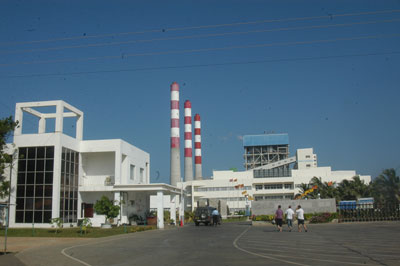View(s): 645
Focus
Cancelling power plants is great fun. Even a child can do it. Building a new one, especially a large power plant and a new gas terminal, is so hard, and the Government is learning that the hard way. Learning for the fourth time, by exactly the same group of people running the Government; both now and then.

File picture of the Norochcholai Coal Power Station
In 1993, they kept shifting a major power plant from Trincomalee (east) to Mawella (south) to Norochcholai (west), as if Sri Lanka needs only one power plant for ever.
Then they meddled with a bid for a relatively tiny 40 MW power plant which was to be a stop gap measure, and the power system went into a great mess in 1996. Remember the 8-hour power cuts in 1996? That’s it.
From 1996 to 1999 they meddled with Norochcholai, in a red light, green light, red light cycle, and finally meddled with even the stop gap power plant to make up for the delay of Norochcholai, and then the country went into enormous blackouts in 2000 and 2001, months on end. The Government was thrown out of power, among other things, owing to mishandling of the power sector.
The meddling continued when the new Prime Minister finally “cancelled” Norochcholai power plant in 2002, and sent the Japanese away. He also “cancelled” the Upper Kotmale power plant in 2002. Then replaced them with two diesel power plants. Great, isn’t it?
Now in the fourth cycle of meddling with power plans, they cancelled the Trincomalee (Sampur) power plants in 2015 (not one but two power plants were cancelled). For three years, the President and the Prime Minister are still looking for that illusive “friend” or the “friendly country” to build a gas terminal for Sri Lanka, to make up for the cancelled power plants.
The political meddling is now amply supported by the legally established Public Utilities Commission (PUC) as well, giving legitimacy to what basically are political and commercial decisions to build, not to build or to shift power plants. By end November 2017, PUC proudly announced that 36 per cent of electricity production in the country over January-November 2017 came from diesel and fuel oil. If PUC’s efforts succeed (they will surely succeed, since that’s precisely what the politicians need), the country will report 50 per cent of electricity production from oil by 2020. Great, isn’t it, to again approach the status of an oil-rich, West Asian country to produce more and more electricity from oil?
The national energy balance says that the highest share of electricity produced from oil was in 2004, reaching 64 per cent in 2004, thanks to the Government of 2001-2004. The lowest share from oil was 18 per cent in 2015. The oil bill this year to produce electricity will exceed Rs. 80 billion, making the bond scam look like peanuts, and the power generation oil bill to look like coconuts.
Engineers do not know anything about power generation. Politicians and their hangers-on are the great planners of electricity systems. Short of putting their fingers in between two high voltage wires, they have done everything possible to change the power plans to suit their perceptions and commercial interests.
Now at the end of 2017, the reservoir storage is at an unhealthy 70 per cent; the inter-monsoon has ended. One unit of Norochcholai is down for long maintenance (note the PM sent the Japanese away in 2002, and a subsequent President got the Chinese to do it in 2005, of course to Chinese standards but for the Japanese price).
So the writing is on the wall.
Only a miracle can save Lanka from power cuts in 2018. Actually, there is no need for a miracle; if the country has adequate money, the same decision-makers will be very happy to award contract for more diesel power plants, and extend the contracts for existing ones they have already ordered.
Remember who cancelled the two power plants in Trincomalee in 2015, which were to produce electricity from 2019. If they were allowed to be built, the upcoming agony in 2018 would be short-lived. But now, the agony will continue (for the electricity customer and the economy), but the party will continue (for the decision-makers).
So when the electricity costs increase, the Government will say (and has already said) that electricity prices will not be increased. What they do not say is that costs of additional diesel power plants would be paid for possibly from telecom taxes or by cutting off expenses on health and education.
Either way, the customer and the economy will surely be the losers. I do not have to explain who the winners are.

